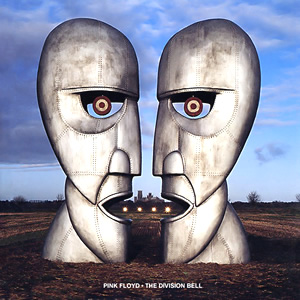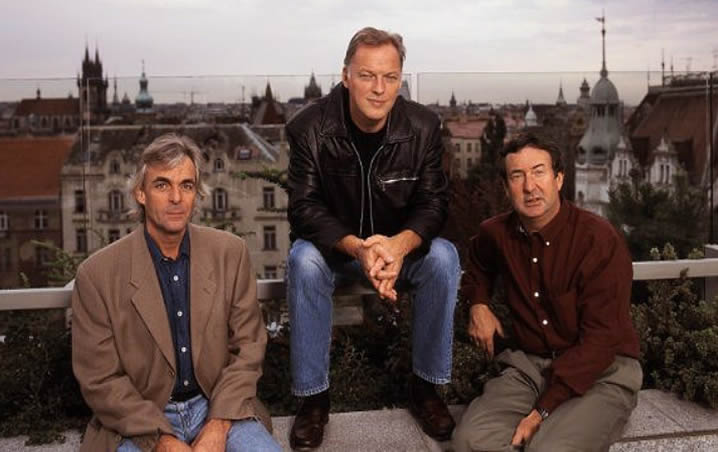The Division Bell by Pink Floyd
 Pink Floyd completed their extraordinary recording career with 1994’s The Division Bell, the longest single album the group had ever recorded (there were a few double albums along the way). More importantly, both compositionally and musically, this album was a true collaboration among the three remaining members of the group, something that had now truly happened in over twenty years (since The Dark Side of the Moon). This was, in part, due to the full return of founding member and keyboardist Richard Wright, who had only performed with the band as a hired player over the course of 15 years. The end result was the most complete Pink Floyd album since The Wall in 1979.
Pink Floyd completed their extraordinary recording career with 1994’s The Division Bell, the longest single album the group had ever recorded (there were a few double albums along the way). More importantly, both compositionally and musically, this album was a true collaboration among the three remaining members of the group, something that had now truly happened in over twenty years (since The Dark Side of the Moon). This was, in part, due to the full return of founding member and keyboardist Richard Wright, who had only performed with the band as a hired player over the course of 15 years. The end result was the most complete Pink Floyd album since The Wall in 1979.
After Roger Waters left the band in the mid 1980s, guitarist/vocalist David Gilmour and drummer Nick Mason recorded A Momentary Lapse of Reason as the next Pink Floyd album. This sparked lawsuits by Waters, who also attempted to subvert the subsequent tour by threatening promoters who used the Pink Floyd name. Eventually, the parties reached a legal agreement that gave Mason and Gilmour the right to use the Pink Floyd name. In early 1993, Wright joined the duo, working collaboratively and jamming on material for a new album.
Bob Ezrin returned to co-produce the album, with much of the recording taking place on Gilmour’s houseboat Astoria. Starting with about twenty-five tracks, the group chose eleven cuts with themes of communication as well as many references to former members Waters and Syd Barrett. Joining the three core members is bassist Guy Pratt, who played on the previous album and tour and had since married Wright’s daughter.
 The Division Bell by Pink Floyd |
|
|---|---|
| Released: March 28, 1994 (EMI) Produced by: Bob Ezrin & David Gilmour Recorded: Astoria, London, January—September 1993 |
|
| Track Listing | Group Musicians |
| Cluster One What Do You Want from Me Poles Apart Marooned A Great Day for Freedom Wearing the Inside Out Take It Back Coming Back to Life Keep Talkin’ Lost for Words High Hopes |
David Gilmour – Lead Vocals, Guitars Richard Wright – Piano, Keyboards, Vocals Nick Mason – Drums, Percussion Guy Pratt – Bass, Vocals |
Fittingly, only the three band members perform the opening soundscape, “Cluster One”, which is also the first Pink Floyd song credited to Wright/Gilmour since “Mudmen” on the 1972 album Obscured By Clouds. After a two minute swell for the intro, the piece goes through another four minutes of new-agey notes from Wright’s piano and Gilmour’s guitar, with Mason joining in much later to add some light percussion. “What Do You Want from Me” is the first of many tracks on this album co-written by Gilmour’s soon-to-be-wife Polly Samson. Musically, the slow, bluesy groove held together by Pratt’s deliberate bass countered by Gilmour’s frantic riffing. The timing on this track is quite impressive because it works well while being so incredibly slow, especially during the extended outro part which masterfully employs rock riffs and vocal harmonies.
The most underrated song on the album is “Poles Apart”, which fades in with a quality and moody acoustic phrase and never loses its charm which brings Floyd right back to its heart in the late 60s and early 70s. Gilmour’s vocals are at their brightest and most inspiring and even the odd, synth-driven, carnival-like mid-section works well in maintaining the nostalgic and slightly melancholy mood of the song. This all culminates with the strong final verse, laden with philosophical lyrics;
“the rain fell slow down on all the roofs of uncertainty, I thought of you and the years and all the sadness fell away from me…”
Although it was highly lauded to the point of where it won the 1995 Grammy Award for Best Rock Instrumental Performance, “Marooned” really doesn’t quite fit into this part of the album’s journey, as a follow-up to the impressive “Poles Apart”. Here better attention to concept details and sonic flow might have worked better. “A Great Day for Freedom” has a duality of moods with the piano being melancholy while the melody and lyrics are more optimistic and hopeful. Gilmour provides an impressive lead during the outro, reminiscent of “On the Turning Away” from their previous album, seven years earlier. The song celebrates the great hopes following the fall of the Berlin Wall, but many interpreted it as a reflection on Gilmour’s estranged relationship with Waters. Wright performs lead vocals on “Wearing the Inside Out”, another first in over two decades. The saxophone solo right at the jump by Dick Parry sets a great mood, but overall the six and a half minute song is pretty slow moving, save for Wright’s slight synth lead in the middle. The real highlight comes in the third verse when Gilmour provides a reflective vocal with rich chorus accompaniment;
“look at him now, he’s paler somehow but he’s coming around, he’s starting to choke it’s been so long since he spoke but he could have the words right from my mouth…”
“Take It Back” may be Gilmour’s most impressive musical performance, between the melodic vocals and various guitar textures. With a genius use of an e-bow, and a great lead during the moody, sound-laden middle section, this song ranks right up there with Pink Floyd’s best guitar songs (and there have been many). “Coming Back to Life” starts with a gentle, bluesy guitar intro and is overall not a bad listen. However, Gilmour seems to have an annoying habit of projecting his own guilt back at the audience and the lyrics on this song illustrate that fact.

The album finishes strong with three solid tracks composed by Gilmour and Samson. While the song itself is really not that interesting, “Keep Talking” has a masterful arrangement starting with the vocal interludes by Stephen Hawking to the extensive use of a “talk box” and the call and response of the verses between Gilmour and the female chorus. The first single released from the album, the song topped the Album Rock Tracks chart in the U.S. for six weeks. “Lost for Words” fades in masterfully with deep organ drone before it finally gets to the folkish, acoustic heart of the song, complete with slight accordion and honky piano and a fine acoustic lead in the outro of the song. “High Hopes” is the final song of the final album and Pink Floyd’s long recording career. Starting with joyous bells in the distance of a rural scene, the lyrics speak of the things one may have gained and lost in life. Fittingly, the song concludes with a fine, bluesy guitar lead by Gilmour.
Despite lukewarm reviews by the mainstream press, The Division Bell topped the charts on both sides of the Atlantic and in several nations across the globe. The group toured throughout much of 1994, playing their final full concert on October 29th of that year. Over a decade later, Waters, Gilmour, Mason, and Wright performed a handful of songs as Pink Floyd at the Live 8 concert in London’s Hyde Park in 2005, the last ever performance by Pink Floyd.
~
Part of Classic Rock Review’s celebration of 1994 albums.






The Division Bell by Pink Floyd Pink Floyd – Pink Floyd
February 10, 2020 @ 4:41 am
[…] Source link […]
April 13, 2020 @ 7:12 pm
Great review, but… Not a single word about TAKE IT BACK. how come??? :-)
April 18, 2020 @ 8:31 pm
Felipe, it seems that a few sentences were omitted, but we corrected the mistake.
April 12, 2022 @ 4:10 pm
I still love this album one of their best
June 3, 2022 @ 12:02 am
I’m hearing it for the first time now and I’m really enjoying it.
The Endless River by Pink Floyd | Modern Rock Review
June 11, 2022 @ 11:58 am
[…] half a century ago. The album is predominantly derived from 1993 sessions prior to the release of The Division Bell and is comprised of instrumental and ambient tracks with only one proper “song” having […]